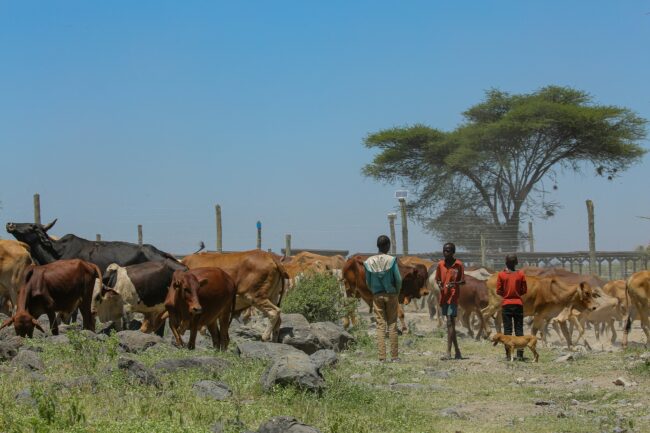
When wildfires sweep through neighborhoods, insurance is often the last line of defense. But increasingly, that defense is disappearing. Recently, the insurance industry has responded to severe climate risks by withdrawing coverage from higher-risk areas. Between 2016 and 2023, nearly 70% of global disaster losses went uninsured, representing up to $260 billion in losses each year. The gap is growing, and with it, the vulnerability of communities already on the front lines of climate change.
Insurance does not have to be just a payout after a tragedy. When designed thoughtfully, it can act as a lever for resilience. One example is the African Risk Capacity, which pioneered satellite-based index insurance, tying payouts to environmental data. In February 2017, as pastoralists across Kenya’s arid north braced for another brutal dry season, the Kenya Livestock Insurance Program stepped in, sending payouts of nearly Ksh 215 million (about US $2.1 million) to thousands of families, based entirely on satellite-monitored grazing conditions. The program was developed by the Kenyan government, the World Bank and private insurers to reach small-scale livestock holders through cooperatives and microfinance institutions.
Key Insights from Our Research
Our capstone project, for the M.A. in Climate and Society at Columbia Climate School, explored how insurance can be more than a safety net. We collaborated with R2 Resilience, a pre-seed company that seeks to innovate in the commercial property sector by identifying top adaptation measures that can both reduce risk and expand access to insurance. Their approach is simple: If insurers reward resilience upgrades with lower premiums or better coverage, property owners are more likely to invest in adaptation.
For example, in wildfire-prone areas, buildings that remove dense vegetation, create “defensible spaces” around a property or utilize fire-resistant building materials are implementing highly effective measures to reduce wildfire risk. These proactive risk-reduction measures should also be reflected in insurance coverage and premiums.
If insurers reward resilience upgrades with lower premiums or better coverage, property owners are more likely to invest in adaptation.
Our research revealed both the promise and pitfalls of using insurance as a driver of climate resilience. One theme kept surfacing: Insurance is only as strong as the data behind it. Yet in many regions, the information needed to evaluate risk and price resilience is inconsistent. This becomes even more complex in developing countries, where there is generally a lack of standardization of buildings or limited uniformity in building codes. Additionally, certain risk data (e.g., building material inventories and historical flood maps) may often be collected and labeled differently across geographies, making it challenging to price climate resilience efforts.
One employee of an international organization told us: “In most developing countries, infrastructure is constructed or owned by the private sector, which is not worried about intergenerational inequity.” This points to a deeper tension: Resilience is not only about the right technology or model, but also about the incentives of the people shaping the system. Efforts that integrate community knowledge, including farmers’ firsthand accounts of drought patterns, into scientific tools such as satellite imagery could provide a shared foundation for decision-making.

Another challenge is that maps traditionally used in insurance capture only those areas where hazards have occurred in the past. Climate change, however, is redrawing those maps. Wildfires burn where they never did before; floods reach neighborhoods considered to be safe. Scenario forecasting asks the “what if” questions—what if sea levels rise by half a meter? What if extreme heat forces mass migration inland? But these models are limited. If insurers could better anticipate cascading impacts, such as how a wildfire might trigger blackouts, which in turn strain hospitals, they could design better coverage.
Even where resilience measures exist, incentives are often misaligned. Reinforcing a roof or installing flood barriers rarely leads to lower premiums, largely because insurers lack a trusted way to verify these efforts. Without financial recognition, property owners have little reason to invest. Some of the most promising solutions lie in parametric insurance, because funds arrive quickly, and trust in the system grows.
That trust can be strengthened when insurance is organized at the community level. Representatives from the International Research Institute for Climate and Society, part of the Columbia Climate School, described how groups of farmers improved the identification of drought impacts by pooling their knowledge. Our research highlighted the importance of local knowledge, which can sharpen risk identification in ways that satellite data alone cannot do. That resilience is even stronger when insurance is embedded in multistakeholder collaborations to co-develop coverage models.
As one U.S.-based researcher put it: “The biggest pain point is that insurance cannot yet account for compound risks.” Insurance is often sold on annual cycles. Long-term threats to property values and affordability—such as rising seas and intensifying storms—fall outside that window. The system also struggles with communication. Many stakeholders described insurance as “opaque and intimidating,” discouraging participation.
A rare counterexample comes from California’s Jumpstart program: When an earthquake breaches a seismic threshold, customers simply receive a text message confirming a $10,000 deposit—no paperwork, no delays. By making payouts seamless, insurance becomes both accessible and trusted. New financial tools are beginning to supplement these efforts. Catastrophe bonds (also known as “CAT bonds”) allow insurers and governments to transfer risk to investors. In 2024, for example, the World Bank issued four CAT bonds for Mexico, providing nearly $600 million in coverage for earthquakes and hurricanes.
Together, these insights underscore both the potential and the limitations of insurance as a catalyst for resilience. To succeed, the system must evolve to become more data-driven, transparent and closely aligned with the realities of the communities it aims to protect.
Chesang Rotich is a graduate of the M.A. in Climate and Society program at Columbia Climate School, where she focused on climate risk, resilience and innovative insurance solutions. She has worked on projects at the intersection of climate policy, finance and community resilience.
Views and opinions expressed here are those of the authors, and do not necessarily reflect the official position of the Columbia Climate School, Earth Institute or Columbia University.


